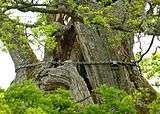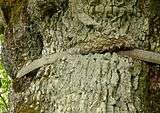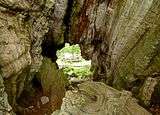Rumskulla oak

The Rumskulla oak, also known as the Kvill oak, is an oak tree (Quercus robur)[1][2] near Norra Kvill National Park in Rumskulla socken, Vimmerby, Kalmar County, Småland, Sweden. It is the oldest oak in Sweden and one of the largest trees in Scandinavia, and was first described in 1772.
History
The tree is more than 1,000 years old[3] and was first described by Magnus Gabriel Craelius in 1772 in Försök till ett landskaps beskrivning ("Essay in the description of a landscape").[1] It is 14 metres (46 ft) high, with a trunk approximately 13 metres (43 ft) in circumference and a volume of approximately 60 cubic metres (78 cu yd), making it one of the largest trees in Sweden.[4] According to Eksjö Municipality, it is the oldest tree in Scandinavia and the largest in circumference.[5][6]
There was an iron band around the trunk to support it, thought to have been put there in the 19th century. It was partially replaced after being cut in 2005 by someone who said he wanted to "free" the tree.[7] It was replaced in 2013 by an arborist. A chain a little higher up prevents the trunk from splitting; the tree is now completely hollow. Climbing has been forbidden since 1998 and there is a fence around the tree; going closer than 5 metres (16 ft) is not permitted.[8]
The hollow trunk of the tree was the location for sex scenes in I Am Curious (Yellow), a 1967 film by Vilgot Sjöman.[5][9][10] The film was controversial when first released, including being banned in Massachusetts; in a case that went all the way to the Supreme Court of the United States, it was ultimately determined not to be obscene.[11][12]
Nature reserve
The Rumskulla oak is registered as a national natural object of interest with the Swedish National Heritage Board and in 2008, the Kvill Nature Reserve (Swedish: Kvills naturreservat) was created around it as the first nature reserve in the municipality. The 29.4-hectare (73-acre) preserve was created to preserve a traditionally open landscape with large oaks and other deciduous trees which contrasts with the nearby pine woods.[13] It is adjacent to Norra Kvill National Park.[14] The tree is accessible for disabled people.[15]
Close-up views of trunk
See also
References
- 1 2 "Rumskullaeken—Sveriges grövsta träd", Naturreservat, Vimmerby, Länsstyrelsen Kalmar län, retrieved 17 November 2013 (Swedish) (pdf)
- ↑ Kerstin Jonsson, Rumskullaeken (Quercus robur), Azote, retrieved 18 November 2013 (Swedish)
- ↑ Faktablad: Skyddsvärda träd i kulturlandskapet, Länsstyrelsen Kalmar (Swedish) (pdf)
- ↑ "Sveriges största lövträd", Norgig, updated 30 October 2009 (Swedish)
- 1 2 "Mariannelund", Eksjö kommun, retrieved 17 November 2013 (Swedish)
- ↑ Eva Hernbäck, "Stor, större störst", Dagens Nyheter, 3 August 2002 (Swedish)
- ↑ "Sabotör ville befria gammal ek", Svenska Dagbladet, 15 July 2005, updated 12 October 2007 (Swedish)
- ↑ Lars Landström, "Vackert om den älskade eken", Allehanda.se, 25 October 2010 (Swedish)
- ↑ Sveriges Natur 78 (1987) p. 118 (Swedish)
- ↑ Vilgot Sjöman, I Am Curious (Yellow), scenario tr. Martin Minow and Jenny Bohman, Evergreen black cat book B-184, New York: Applause, 1968, ISBN 978-0-936839-53-0, p. 140.
- ↑ Supreme.justitia.com:BYRNE v. KARALEXIS – 396 U.S. 976 (1969). Retrieved 17 November 2013.
- ↑ Supreme.justitia.com:Byrne v. Karalexis – 401 U.S. 216 (1971). Retrieved 17 November 2013.
- ↑ "Naturreservatet i Kvill", Norra Kvill, Naturskyddsföreningen, updated 3 July 2013 (Swedish)
- ↑ "Naturminnen", Länsstyrelsen Kalmar län, retrieved 17 November 2013 (Swedish)
- ↑ "Invigning vid Kvilleken", Länsstyrelsen Kalmar län, retrieved 17 November 2013 (Swedish)
External links
 Media related to Rumskulla oak at Wikimedia Commons
Media related to Rumskulla oak at Wikimedia Commons- Per Eliasson. "Rumskullaeken: Sveriges äldsta träd". Nationalencyklopedin 2002 (Swedish)
- Kvill Oak. Vimmerby tourist office
- Photo (June 2014)
- International Oak Society.org – look for "The Mighty Oak of Kvill"
Coordinates: 57°44′5″N 15°37′44″E / 57.73472°N 15.62889°E




